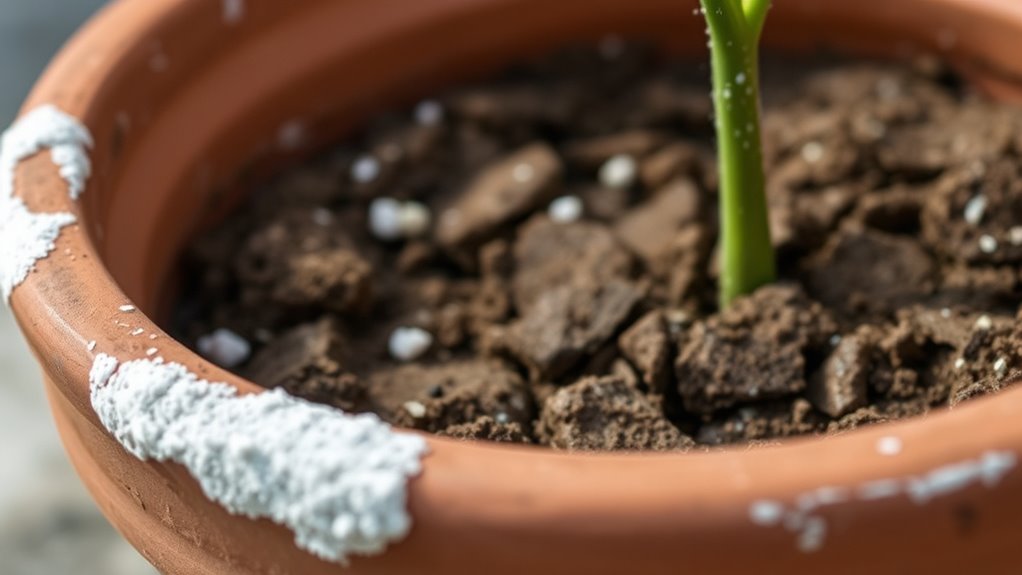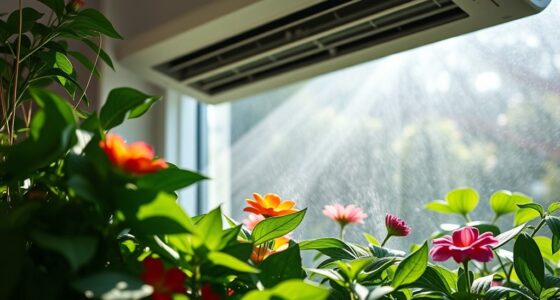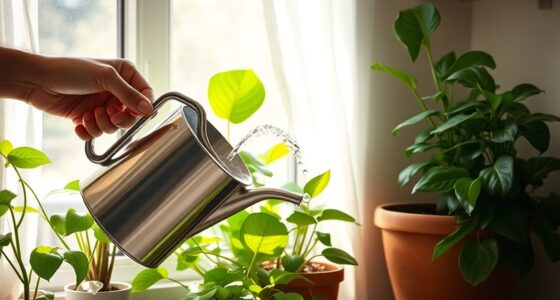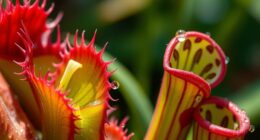If you notice salt buildup in your pots, start with flushing by watering thoroughly until excess water drains out; this often helps remove mild salt deposits and is quick to do. If signs persist like crusty soil, yellow leaves, or damaged roots, consider repotting your plant into fresh soil to eliminate stubborn salts and inspect root health. Keep in mind, choosing the right method depends on severity—follow along to learn which approach works best for your plant’s recovery.
Key Takeaways
- Use flushing for mild salt buildup detected early with white crust and yellowing leaves.
- Consider repotting if flushing doesn’t improve plant health or salt deposits persist.
- Flushing involves watering thoroughly until runoff to leach salts; repotting replaces contaminated soil completely.
- Regular use of distilled or rainwater can prevent future salt accumulation.
- Assess severity and symptoms to choose the appropriate method for maintaining plant health.

Salt buildup in pots can be a common issue, especially if you frequently water your plants with hard water. When minerals like calcium and magnesium are present in high concentrations, they tend to accumulate on the soil surface and around the roots over time. This buildup can hinder your plant’s ability to absorb nutrients and water properly, leading to stunted growth or even health decline. Recognizing the signs early is essential; you might notice a white crust on the soil surface, yellowing leaves, or slowed growth. Once you see these symptoms, you need to decide whether to flush the soil or repot your plant entirely.
Flushing is often the simplest first step. It involves thoroughly watering the plant with a generous amount of water, allowing the excess salts to be washed out of the soil. To do this effectively, water until you see runoff from the drainage holes, then let the pot drain completely. Repeat this process a few times over several days to help leach out the accumulated salts. This method is especially useful if the salt buildup is recent or not severe. It’s quick, requires no additional potting materials, and can often restore your plant’s health without much hassle. However, keep in mind that flushing may not always remove all the salts, especially if the buildup has been ongoing for a long time or if the soil is heavily compacted.
If flushing doesn’t improve your plant’s condition, or if you notice persistent salt deposits or root damage, repotting might be necessary. Repotting involves removing the plant from its current container, gently shaking off old soil, and replacing it with fresh, well-draining potting mix. This approach ensures that all the salt residues are removed along with the old soil, giving your plant a fresh start. When repotting, it’s a good idea to choose a slightly larger pot to accommodate new growth and to use distilled or rainwater to prevent future salt buildup. Repotting can be more labor-intensive, but it’s often the most effective way to deal with severe salt accumulation and root health issues. It also gives you the chance to inspect the roots and trim away any damaged or rotted parts, promoting healthier growth. Additionally, selecting appropriate soil can help minimize future salt problems.
Ultimately, your choice depends on the severity of the buildup and your plant’s condition. Start with flushing for minor issues and move to repotting if necessary. Both methods can help protect your plant’s health and keep it thriving, so assess the situation carefully and choose the approach that best suits your plant’s needs.
Frequently Asked Questions
How Often Should I Check for Salt Buildup in My Pots?
You should check for salt buildup in your pots every few weeks, especially during the growing season. Keep an eye out for a white crust on the soil surface or along the pot’s edges. Regularly inspecting helps you catch buildup early, preventing damage to your plants. If you notice excessive salt deposits, flush the soil with water or consider repotting to keep your plants healthy and thriving.
Can Salt Buildup Harm My Plant’s Roots?
Yes, salt buildup can harm your plant’s roots. It creates a crust that can block water and nutrient absorption, leading to root stress or rot. Over time, high salt levels can weaken your plant, making it more susceptible to pests and diseases. To prevent this, regularly flush your pot with water to wash away excess salts, especially if you notice white crusts or decreased plant vigor.
Are Some Types of Pots More Prone to Salt Buildup?
Yes, some pots are more prone to salt buildup. Clay or terracotta pots, with their porous surfaces, absorb salts from watering and fertilizers, making buildup more likely. Plastic or glazed ceramic pots are less absorbent, reducing salt accumulation. To prevent issues, choose non-porous containers if you notice salt buildup, and regularly flush your plants or repot when necessary. Proper watering and drainage also help minimize salt issues over time.
Does Salt Buildup Affect Soil Nutrients?
Salt buildup can deplete soil nutrients, much like a leaky faucet draining a water tank. When salts accumulate, they interfere with a plant’s ability to absorb essential nutrients, causing deficiencies. I once neglected to flush my potted herbs, and their growth slowed dramatically. Regular flushing or repotting helps restore nutrient balance, ensuring your plants stay healthy and vibrant. Ignoring salt buildup risks long-term nutrient loss and plant decline.
Can Natural Remedies Remove Salt Deposits Effectively?
Yes, natural remedies can effectively remove salt deposits. You can try rinsing the soil thoroughly with water to flush out excess salts, which helps restore nutrient balance. Additionally, adding organic materials like compost or mulch can improve soil health and reduce salt buildup over time. Regularly watering your plants with plain water and avoiding over-fertilization also helps prevent salt accumulation. These natural methods support healthy plant growth without harsh chemicals.
Conclusion
When salt builds up in your pots, think of it as a stubborn stain on a favorite shirt—you can’t ignore it forever. Flushing the soil is like washing away the dirt, restoring your plant’s health. If the buildup’s severe, repotting might be your best move, giving your plant a fresh start. Either way, staying attentive guarantees your plant remains vibrant and happy, like a well-tended garden blooming in spring. Keep an eye out, and your green friends will thank you.










